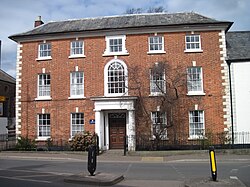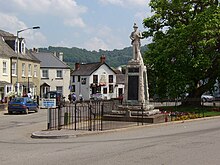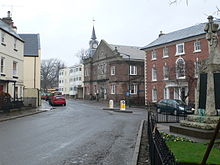| St James House, Monmouth | |
|---|---|
 St James House at St James Square St James House at St James Squareand Whitecross Street | |
| General information | |
| Address | 10 St James Square 10 Whitecross Street |
| Town or city | Monmouth |
| Country | Wales |
| Coordinates | 51°48′48″N 2°42′41″W / 51.813235°N 2.711477°W / 51.813235; -2.711477 |
| Designations | Grade II Listed |
St James House is a grade II listed building in Monmouth, Monmouthshire, Wales. It is in the historic St James Square neighbourhood, within the Medieval town walls. While the house currently has an attractive, 18th-century facade, it originated as a burgage tenement. In addition, behind the house, evidence of a kiln has been unearthed, with both Medieval and Post-medieval pottery. In 2010, archaeological excavation in the square revealed the first evidence of Mesolithic human settlement in Monmouth. Recent residents of St James House have included boarding students from Monmouth School.
Neighbourhood and location



"There are some lovely spots in the town centre, none prettier than St James's Square, with its old war memorial in the shadow of a romantic-looking tree." This is the description of St James Square (pictured) in Monmouth, Wales that appeared in The Telegraph of 25 February 2006. The war memorial mentioned is the Monmouth War Memorial that was installed in the square in 1921 and was the work of sculptor W. Clarke of Llandaff. The "romantic-looking tree" is a reference to the Catalpa or Indian Bean Tree that was planted on the square in about 1900.
St James House (pictured) is located at the eastern end of Whitecross Street, where it terminates at the roundabout encircling the triangular St James Square. The building is positioned on the north side of the square, across from 33 Whitecross Street (pictured), the site of archaeological excavation in 2009. St James House lies within the Medieval town walls which were built around 1300. On the 1610 map of Monmouth (pictured below) by cartographer John Speed, the area which served as the site for St James House is depicted adjacent to the label for the East Gate (Dixton Gate). However, as discussed by author William Meyler Warlow, the square, as well as the road south of it, including the future St James Street and Almshouse Street, were all considered to be part of Whitecross Street during the early 17th century. A white cross, which gave its name to the street, stood in the square (see map). As is the case with some other houses on the eastern leg of Whitecross Street, St James House has had two addresses: 10 St James Square and 10 Whitecross Street.
Design and burgage history
St James House was grade II listed on 27 June 1952. The listed building has an 18th-century facade with a three-storey, five-bay elevation. The exterior is red brick, highlighted by light-colored, raised stone quoins which serve as the cornerstones of the walls, contrasting with the brick. Decorative keystones of similar material are atop all of the windows except one, which is lugged and scrolled. The bays on the ground and first floors are rectangular, while those on the uppermost floor are square. The exception is the tall, centre window on the first floor which is round-headed. The centrally-positioned entrance features a wood portico supported by Doric columns. A fanlight is present above the door. The roof is flared and hipped. The interior has a small amount of 17th-century plasterwork.
St James House is considered to be a good representation of the burgage tenements that were common during Medieval times (link to glossary below). Its origins as a burgage are most evident at the rear of the property. The current, 18th-century facade was a later addition. Burgage tenements were rental properties that were often long and narrow plots of land, particularly in towns where frontage property along a street was at a premium. The gable (narrow) end of a house on a burgage plot usually faced the street. While the classical style was in vogue during the 18th century, many burgage houses received new brick facades. Such was the case with St James House.
Archaeology
Important archaeological finds have been excavated both at St James House and its neighbourhood. Behind St James House, evidence of a Post-medieval pottery kiln has been unearthed. The kiln at St James House produced Welsh Borderland ceramics of the A7d type. Other Monmouthshire 17th-century kilns which produced this pottery included Abergavenny and Trefaldu at Cwmcarvan. A few sources of A7d pottery have been located outside of Monmouthshire as well, including Herefordshire. In addition, a base sherd of Spanish ware excavated by Socket in 1956 at St James House was found to be Medieval, of the early 15th century.
On 8 November 2010, the BBC News reported that during the course of gas main replacement work at St James Square and Wyebridge Street, Mesolithic era artefacts, including flints, were excavated (link to photograph of flints below). An article by Sion Morgan of the Western Mail which also ran on 8 Nov 2010 in Wales Online suggested that similar artefacts were found in St James Street as well. This represented the first discovery of Mesolithic human settlement in Monmouth.
Residents of St James House
In 1891, Chippenham House, a grade II listed building at 102 Monnow Street, was home to surgeon Thomas Gilbert Prosser (1856–1932), a native of Monmouth. However, the doctor lived at St James House on Whitecross Street in 1901 and 1911. In Kelly's Directory of Monmouthshire 1901, Part 2, he is listed as both a county and borough magistrate. In Part 3 of the directory, he is listed as a medical officer at the Hospital & Dispensary. Prosser, a member of the Royal College of Surgeons, died on 5 Nov 1932 in Monmouth.
William Humphrey Williams (1880–1948), licensed by the Royal College of Physicians and a member of the Royal College of Surgeons, followed in the footsteps of Prosser, with regard to both profession and residence. He passed his Anatomy and Physiology examinations of the Royal College of Physicians and Surgeons in July 1903 and, by 1911, he was living at Chippenham House. The following year, on 26 September 1912, he married Nesta Faith Green-Price, daughter of Sir Richard Dansey Green-Price and granddaughter of Sir Richard Green-Price, in Radnorshire. By 1923, Williams was the Medical Officer of Health for Monmouth and the Williams family resided at St James House. The physician was also medical officer for the Rockfield district and public vaccinator for the Monmouth district. In addition, Williams was medical officer for the Borough Fever Hospital. Williams and his wife lived at St James House prior to Williams' death on 2 March 1948 in Monmouth.
Later, St James House served as a junior boarding house for boys ages ten to thirteen at Monmouth School. A J Jones was a housemaster at the St James House location. The Heart Project, a substantial renovation of Monmouth School, was undertaken in early 2011. As part of the first phase of that project, St James House was sold and its boarders were transferred to Chapel House, on the northern segment of Monk Street, in September 2011. The first phase also included redevelopment of The Grange from a prep school to a sixth form boarding house, which also opened in September 2011. The second phase of the school building project has begun.
See also
- Monmouth School
- St James Square, Monmouth
- Whitecross Street, Monmouth
- Monmouth in the Mesolithic period
- Monmouth Town Walls and Defences
References
- Max Davidson (25 February 2006). "City spotlight: Monmouth". The Telegraph. Archived from the original on 28 May 2010. Retrieved 26 May 2012.
- ^ John Newman (11 March 2000). Gwent/Monmouthshire (illustrated ed.). Yale University Press. p. 408. ISBN 9780300096309. Retrieved 26 May 2012.
- "Council v Council in Catalpa Tree Clash". hackersons.co.uk. Monmouth Community. Archived from the original on 8 April 2014. Retrieved 26 May 2012.
- "monmouthshire sir fynwy". idox.monmouthshire.gov.uk. Monmouthshire County Council. Archived from the original on 5 March 2016. Retrieved 26 May 2012.
- "Monnow Bridge". cofiadurcahcymru.org.uk. The Glamorgan-Gwent Archaeological Trust Historic Environment Record. Archived from the original on 6 March 2016. Retrieved 26 May 2012.
- "Virtual Map of Monmouth". monmouth.org.uk. The Monmouth Website. Retrieved 26 May 2012.
- William Meyler Warlow (1899). A history of the charities of William Jones (founder of the "Golden lectureship" in London), at Monmouth & Newland. W. Bennett. Retrieved 26 May 2012.
- ^ "St. James Square, 10, Monmouth; St. James House". coflein.gov.uk. Royal Commission on the Ancient and Historical Monuments of Wales. Retrieved 26 May 2012.
- ^ Prosser, Thomas G. "1901 Wales Census". ancestry.com. Census Returns of England and Wales, 1901. The National Archives of the UK (as re-printed on Ancestry.com).
{{cite web}}: Missing or empty|url=(help) - "St. James's House, Monmouth". britishlistedbuildings.co.uk. British Listed Buildings. Retrieved 26 May 2012.
- ^ "Walking in Monmouth, Monmouthshire and The Wye Valley". monmouth.org.uk. The Monmouth Website. Retrieved 26 May 2012.
- "Question: Burgage plots". Wiltshire and Swindon History Centre. Wiltshire Council. 4 July 2011. Retrieved 26 May 2023.
- "Historic towns and built form". hertslink.org. Hertfordshire – Building Futures. Retrieved 26 May 2012.
- "17th century kilns (post-medieval Welsh Borderland wares)". woolhopeclub.org.uk. Woolhope Naturalists' Field Club, Herefordshire. Retrieved 26 May 2012.
- "The Medieval Ceramics" (PDF). newport.gov.uk. Newport. Retrieved 26 May 2012.
- ^ "Items found in Monmouth shed light on Mesolithic man". BBC News. 8 November 2010. Retrieved 27 May 2012.
- Sion Morgan (8 November 2010). "Monmouth's meeting the ancestors from more than 10,000 years ago". Wales Online. Retrieved 27 May 2012.
- Prosser, Thomas G. "1891 Wales Census". ancestry.com. Census Returns of England and Wales, 1891. The National Archives of the UK (as re-printed on Ancestry.com).
{{cite web}}: Missing or empty|url=(help) - "Chippenham House, Monmouth". britishlistedbuildings.co.uk. British Listed Buildings. Retrieved 27 May 2012.
- Prosser, Thomas Gilbert. "1911 Wales Census". ancestry.com. Census Returns of England and Wales, 1911. The National Archives of the UK (as re-printed on Ancestry.com).
{{cite web}}: Missing or empty|url=(help) - "Kelly's Directory of Monmouthshire 1901 – Monmouth". freepages.genealogy.rootsweb.ancestry.com. hosted by rootsweb. Retrieved 28 May 2012.
- "Kelly's Directory of Monmouthshire 1901 – Monmouth". freepages.genealogy.rootsweb.ancestry.com. hosted by roots web. Retrieved 28 May 2012.
- "The Edinburgh Gazette" (PDF). The Edinburgh Gazette. 3 February 1920. p. 322. Retrieved 28 May 2012.
- Prosser, Thomas Gilbert. "England & Wales, National Probate Calendar (Index of Wills and Administrations), 1858–1966". ancestry.com. Principal Probate Registry. Calendar of the Grants of Probate and Letters of Administration made in the Probate Registries of the High Court of Justice in England (as re-printed on Ancestry.com).
{{cite web}}: Missing or empty|url=(help) - ^ Burke's Peerage – Baronetage & Knightage (107th ed.). Burke's Peerage and Gentry. 2004. p. 1650. Retrieved 27 May 2012.
- International Financial Conference, League of Nations (1903). "The Lancet". Rapport du Comité consultatif: Report of the Advisory committee. Imprimé pour la Société des nations, Harrison & sons. p. 273. Retrieved 27 May 2012.
- Williams, William Humphrey. "1911 Wales Census". ancestry.com. Census Returns of England and Wales. The National Archives of the UK (as re-printed on Ancestry.com).
{{cite web}}: Missing or empty|url=(help) - Burke's Great War Peerage (76th ed.). 1914. p. 1605. Retrieved 27 May 2012.
- Williams, William H. "England & Wales, FreeBMD Marriage Index: 1837–1915". ancestry.com. General Register Office. England and Wales Civil Registration Indexes (as re-printed on Ancestry.com).
{{cite web}}: Missing or empty|url=(help) - "Sir Richard Dansey Green-Price, Bart". Baily's Magazine of Sports & Pastimes. 58: 289–291. November 1892. Retrieved 27 May 2012.
- "U.K., City and County Directories, 1600s–1900s". ancestry.com. Kelly's Directory of Monmouthshire 1923 (as re-printed on Ancestry.com).
{{cite web}}: Missing or empty|url=(help) - Williams, William Humphrey. "England & Wales, National Probate Calendar (Index of Wills and Administrations)". ancestry.com. Principal Probate Registry. Calendar of the Grants of Probate and Letters of Administration made in the Probate Registries of the High Court of Justice in England (as re-printed on Ancestry.com).
{{cite web}}: Missing or empty|url=(help) - "Key Facts – Boarding Houses". habs-monmouth.org. Haberdashers' Monmouth Schools. Retrieved 28 May 2012.
- "Monmouth School St James House Boarders' Handbook" (PDF). monmouthschool.org. Monmouth School. Retrieved 28 May 2012.
- "The Heart Project". monmouthschool.org. Monmouth School. Archived from the original on 13 May 2012. Retrieved 28 May 2012.
External links
- Medieval English Towns – Glossary
- Photograph of Mesolithic flints found in St James Square
- Monmouth School – The Heart Project Archived 13 May 2012 at the Wayback Machine